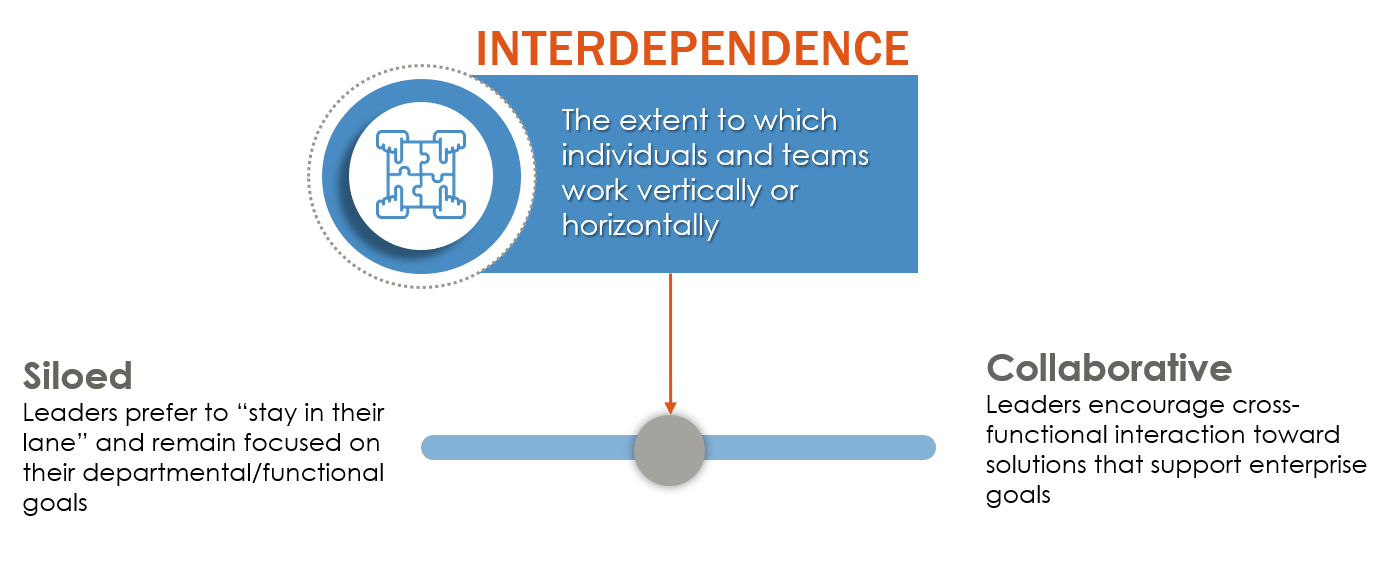Now, let’s be clear. Organizations should not aspire to have 100% collaboration; be devoid of hierarchy; or set loose protocols, processes, and systems. As we talked about in an earlier blog, many cultures and their employees around the globe take great comfort in being directed on their daily tasks. But if these structures limit horizontal teaming, then it is important for the executive leadership team to determine when top-down leadership is value-add, and when it would do better to release the control.
The Secret 7 Culture Conversation: #5 OF 7: INTERDEPENDENCE

In many ways, silo behavior isn’t anyone’s fault. Silo structure came about during the Industrial Revolution, when a “divide and conquer” approach to manufacturing was an efficient path to successful assembly and delivery of product to customer. Standardized process, lean manufacturing, assembly-line mentality and individualistic task completion rolled up to the overall goals for project completion.
This continued as economic globalization ensued. Sourcing and manufacturing moved to lower-cost geographies. At one point, power moved into a regional model, where not only business units were accountable for their own P&L management, but regional “theatres” became owners of their P&L as well. In some ways, this matrix operating model fostered some elements of a decentralized power structure, but power dynamics remained strong and new geographic siloes were created.
There was a biomedical client we worked with years ago who adopted the model of “global/local” in a unique way. This client would invite a cross-geography and cross-business unit guest list to a neutral meeting location to co-develop a global strategy
and set of strategic solutions. Being a Dutch company played in this client’s favor as the cultural behaviors common to many Dutch companies enabled an effective combination of egalitarian leadership, direct speech (comfort with debate and dialogue to get to a better outcome), collective mindset, and comfort with risk-taking and ideation.
Once this cross- geography and cross-functional team had developed the global project plan, they were able to pursue a rapid-cycle development of a new product introduction, leveraging a 24/7, follow-the-sun project management discipline and superior online collaboration tools to keep the conversation going in real-time. Because each leader had been a part of the original co-creation of the global plan, they were able to translate specific sub-steps of the plan in their local geographies, yielding quick implementation and local customization.
Where we have seen weakness or inability to grow beyond current metrics, we often see the organization held back by siloes. People and teams working in their own lanes. Somehow sharing the load with other functions is seen as losing control or power, as opposed to distributing the wealth across the width of the organization.
Cultural features of these vertical-only organizations often include centralization, autocracy, and conventional approaches to task completion. Leaders of P&Ls represented by individual departments or separate business units often seek to maintain control over decision-making, choosing to prioritize budgets that primarily help their individual agendas.
Conversely, the organizations we are increasingly seeing as “best in class” have been willing to go to an uncomfortable place, where they give up control and their authority, and sit with the dissonance associated with invention and innovation. In the end, the yield that comes from horizontal teams, working collaboratively, leveraging each others’each other’s strengths, can far outweigh any short-term benefits that come from sticking to a familiar drum-beat.
For more information on The Secret 7, or if you would like to receive a unique survey link (custom URL), free for your company/organization, please click here and complete the form.












